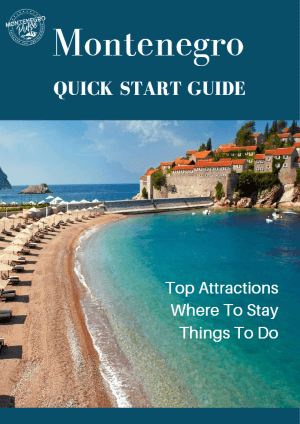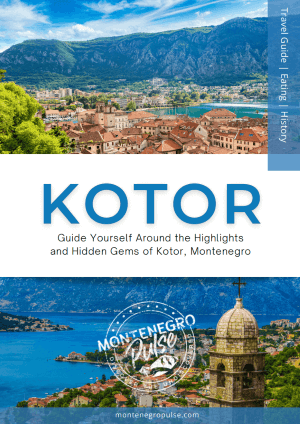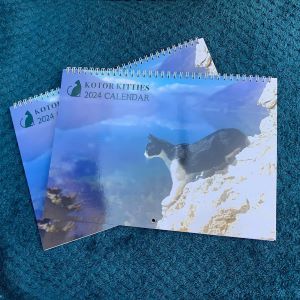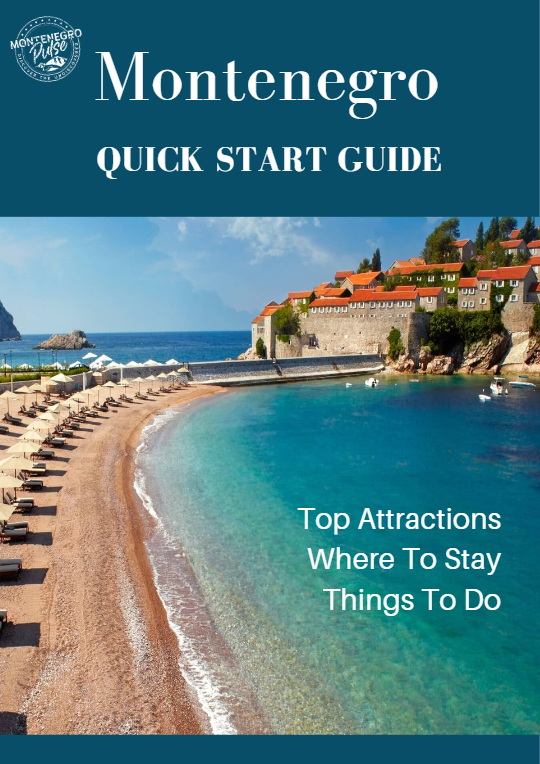Montenegro Pulse contains affiliate links and is a member of the Amazon Services LLC Associates Program. If you make a purchase using one of these links, I may receive compensation at no extra cost to you. See my disclaimer for more information.
The Climate of Montenegro and When to Plan Your Trip
With its pristine beaches, rugged mountains, and bustling medieval villages, Montenegro has something for every explorer.
But what is the weather like in Montenegro and how can it impact your travel plans? Montenegro enjoys both a Mediterranean climate and a continental climate, meaning you’ll need to pack for both during your stay.
In this guide to the climate of Montenegro, I’ll go over what you can expect on the coast, as well as in the mountains of Montenegro throughout the year. I’ll also give you the average weather you can expect for each month, the best times to visit, and the best things to do in each season.
Contents
Overview of Montenegro's Climate | Climate of Montenegro by Season | Climate of Montenegro by Month | Climate of Montenegro by Activity | FAQ
Overview of Montenegro's Climate
The climate in Montenegro is as diverse as its landscapes. There are two main regions in Montenegro: the coastal region and the mountain region.
The climates of these two regions are very different, so knowing what to expect in each will help you plan your trip and pack accordingly.
Montenegro Weather: The Coast of Montenegro
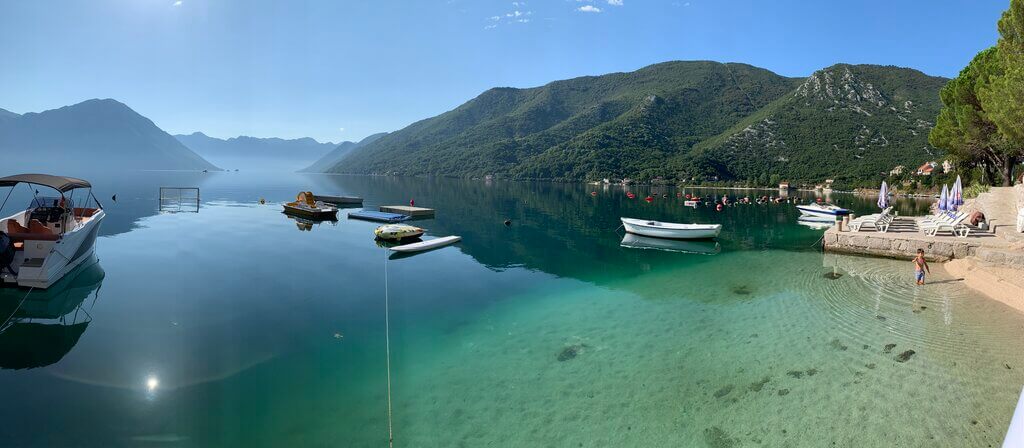 Morinj, Bay of Kotor
Morinj, Bay of KotorThe coastal region of Montenegro enjoys a mild Mediterranean climate, characterized by hot, dry summers and mild, wet winters.
The summers on the coast are always hot and dry. If rain does come, it's usually a short, intense storm that doesn’t last longer than an hour. The average daily temperature generally ranges between about 20°C at night and 31°C during the day (68°F - 89°F) in July and August and the sunshine is guaranteed.
In summer, the evenings are also warm, so they’re perfect for walking along the promenade to a waterfront restaurant or ice cream parlor.
If you’re looking for a beach holiday in the middle of summer with guaranteed sun, this is the place for you!
In winter, temperatures on the coast range from lows of around 0°C (32°F) up to 15°C (59°F) during the day on fine days. Snow is rare on the coast, but it can be very wet in winter. In fact, Crkvice, near the Bay of Kotor, is thought to be one of the rainiest places in Europe.
The wet weather is broken up by brilliant sunny winter days, which are perfect for hiking and coffee in outdoor cafes. Although sunny, these days can be fiercely cold when the strong Bura wind blows over the snow in the mountains and over the coast.
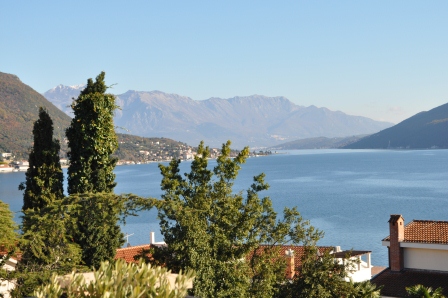 Christmas weather in Montenegro
Christmas weather in MontenegroMontenegro Weather: The Mountains of Montenegro
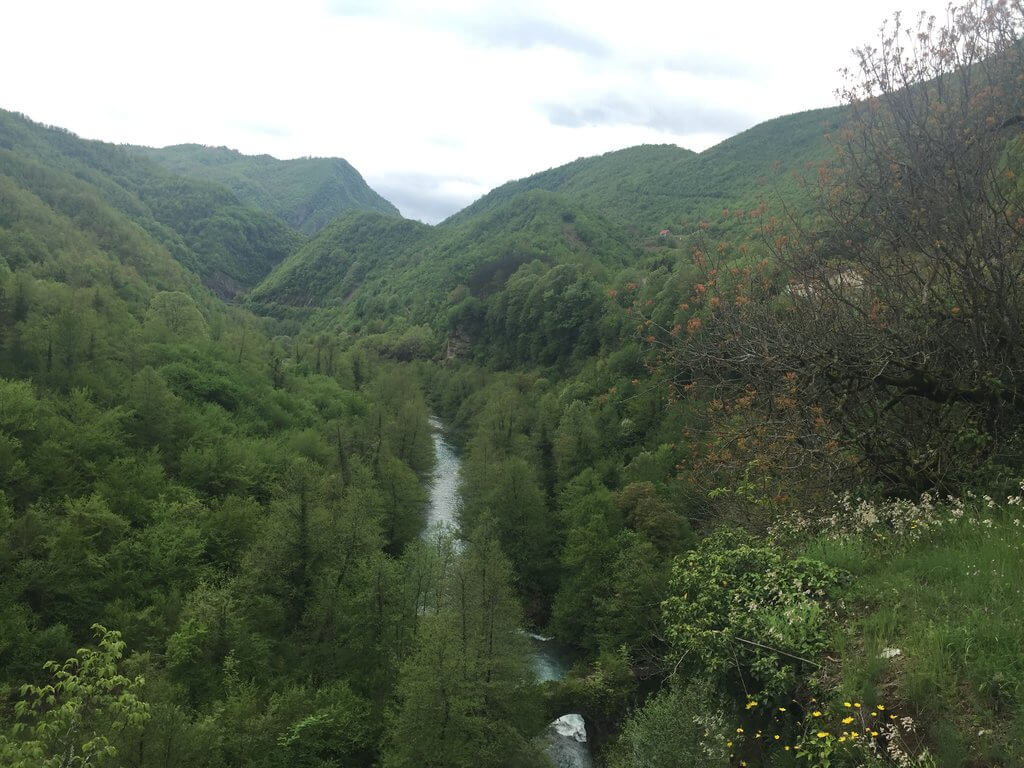 Morača River Canyon
Morača River CanyonAs you move inland, the climate shifts to a more continental type, influenced by higher altitudes. The weather is noticeably cooler here and it can be as cool as 15°C (59°F) in July.
Summer weather is also cooler inland. The temperatures in summer range from around 20°C - 30°C (68°F - 86°F) during the day. This makes Montenegro’s mountains an excellent escape from the intense summer heat of the coast.
If you want to head into the more mountainous northern regions, Žabljak or Kolašin are top destinations that offer plenty of things to see and do.
Žabljak, in Dumitor National Park, is a popular mountain town with dramatic landscapes and hiking trails. Kolašin, just outside Biogradska Gora National Park, also offers beautiful nature in an authentic mountain town.
If this sounds tempting, but you don’t have time to stay overnight, the Montenegro Full-Day Tour to Lovćen and More; Durmitor, Tara, and Ostrog Monastery Day Trip; and white water rafting are excellent day trip options.
Montenegro’s inland region is blanketed in snow in winter. The snow starts in December and usually lasts through to April or even May. Žabljak and Kolašin are Montenegro’s most popular winter ski resorts and have many hotels, restaurants, and things to do.
In the inland and mountainous areas, late spring and summer often bring more rain, along with afternoon thunderstorms, most commonly in May and June. If you plan to head inland during your stay, pack some warm layers and a rain jacket.
When is the Best Time to Visit Montenegro?
The best time to visit Montenegro is between April and the end of October. This is when the weather is warmest and Montenegro's coastal region becomes a buzzing summer hot spot.
However, Montenegro in winter offers a laid-back Christmas alternative and a snowy winter wonderland in the mountains.
The Climate of Montenegro by Season
Montenegro Spring (March, April, May)
Weather Conditions: Expect mild temperatures ranging from 15 to 20°C (59°F to 68°F), with occasional rain showers.
Suggested Activities: Explore the national parks and coastal cities, enjoy bird watching at Skadar Lake, or take part in spring festivals like the Mimosa Festival in the Bay of Kotor.
Packing Tips: Light layers, waterproofs, and comfortable walking shoes are a must.
Spring in Montenegro is a season of transition, offering a blend of mild temperatures and varying weather conditions.
In the coastal regions, you can expect temperatures to range from 12°C to 20°C (54°F to 68°F), making it a pleasant time for sightseeing and light outdoor activities. However, occasional rain showers are not uncommon, so I recommend always carrying a waterproof jacket.
As you move inland, the climate becomes more continental, but the temperatures are generally mild, making it suitable for exploring cities and natural landscapes.
In the mountainous regions, spring is a time of thaw, but it is still very cold. It's an ideal period for spring skiing and witnessing the blooming flora.
Overall, spring in Montenegro offers a range of experiences, making it a versatile time for travel.
Montenegro Summer (June, July, August)
Weather Conditions: Montenegro’s coastal areas can reach 30°C (86°F) or more, while the mountains remain cooler.
Suggested Activities: Hit the beach, explore UNESCO sites like Kotor and Durmitor National Park, or enjoy open-air concerts.
Packing Tips: Don't forget your swimsuits, sunglasses, sunblock, and summer clothing.
The coastal areas from Herceg Novi to Ulcinj are the most popular regions to visit and can become very crowded in July and August. You can expect consistent hot and sunny weather that’s perfect for the beach but can be uncomfortably hot for sightseeing.
If you’re looking to get away from the tourist crowds and get a more complete Montenegrin experience, plan a stay in a mountain destination like Žabljak or Kolašin, where you can enjoy pleasant temperatures, stunning nature, and authentic culture and cuisine.
June is a good month to visit Montenegro, especially if you’re looking for slightly cooler weather for outdoor activities like hiking and don’t mind cooler sea temperatures of 21°C (70°F).
Montenegro Autumn (September, October, November)
Weather Conditions: Temperatures drop to a comfortable 15 to 25°C (59°F to 68°F), with beautiful autumn foliage.
Suggested Activities: Enjoy wine tours, hiking in Biogradska Gora National Park, or cultural festivals.
Packing Tips: Pack layers, a good jacket, and comfortable footwear.
I think September is the best time to go to Montenegro. The weather in the first half of September is ideal beach weather and you can enjoy it without the crowds and congestion of July and August. The general vibe is more relaxed and the prices are cheaper than in peak season.
The second half of September is pleasantly warm and is ideal for the beach while being cool enough to walk around outdoors comfortably. It can also be prone to rain towards the end of September.
The weather in October is generally settled and many days are still warm enough to enjoy the beach. In November the temperature starts to cool much more and you’ll get cool autumn days.
Montenegro Winter (December, January, February)
Weather Conditions: Coastal areas remain mild, while the mountains become a winter wonderland.
Suggested Activities: Ski in the northern resorts or enjoy winter festivals like the carnival in Kotor.
Packing Tips: Bring warm clothing, gloves, a scarf, and suitable footwear.
Montenegro can be an excellent winter destination if you’re looking for a place to escape or recover from the hustle and bustle of Christmas.
Christmas in Montenegro is an understated and quiet time and because most Montenegrins are Orthodox Christian, they celebrate Christmas on January 7th. New Year’s Eve is a big celebration, with free outdoor concerts in all the major towns, including Kotor, Budva, and Podgorica.
Many of the hotels and restaurants on the coast are closed over the winter, but there are always some open year-round and you’ll find some of the cheapest prices in this period.
Montenegro’s mountains become a winter wonderland in winter. Kolašin 1450 is Montenegro’s biggest ski resort and is buzzing with locals who come to ski. Žabljak’s Savin Kuk is a small ski resort that offers a cozy local experience, ideal for beginners and families.
If you’re looking for a real hidden gem of a ski destination, look no further than Kopaonik Ski Resort. This is my absolute favorite place to ski and snowboard in winter!
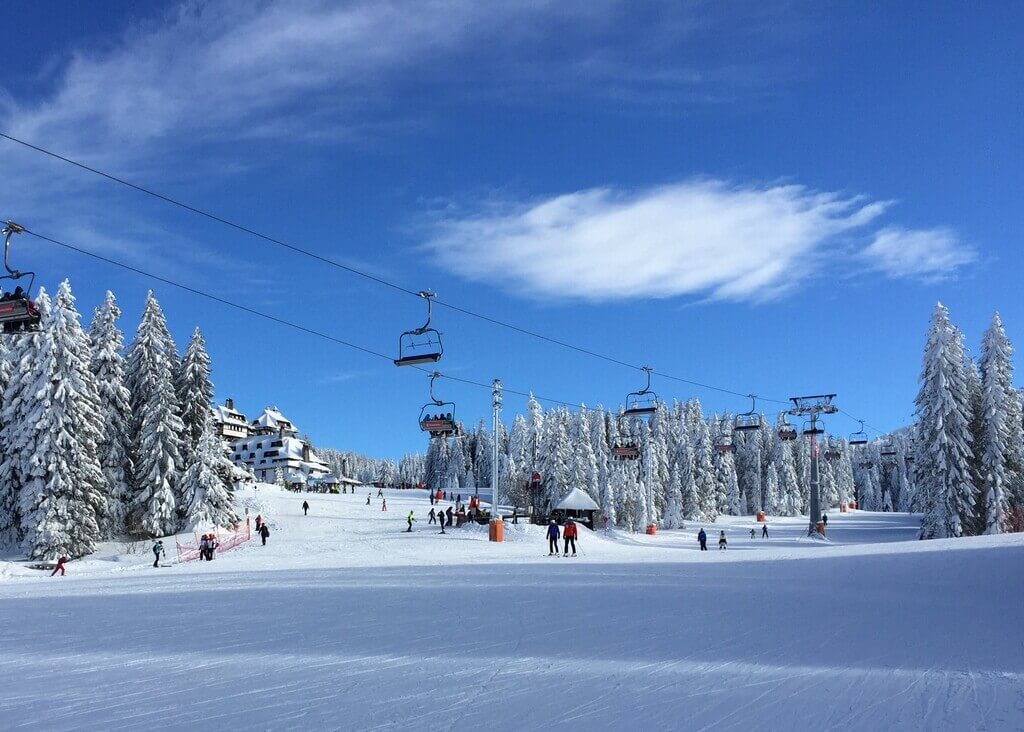 Kopaonik Ski Resort
Kopaonik Ski ResortMontenegro Climate By Month
Weather in Montenegro in January
- January: Cold and snowy in the mountains; milder along the coast.
- Coastal Region: 6°C to 12°C (43°F to 54°F)
- Mountain Region: -6°C to 3°C (21°F to 37°F)
> Read more about the weather in Montenegro in January
Weather in Montenegro in February
- February: Similar to January but with less snowfall.
- Coastal Region: 7°C to 13°C (45°F to 55°F)
- Mountain Region: -5°C to 4°C (23°F to 39°F)
> Read more about the weather in Montenegro in February
Weather in Montenegro in March
- March: Warming up; ideal for spring skiing.
- Coastal Region: 9°C to 16°C (48°F to 61°F)
- Mountain Region: -2°C to 7°C (28°F to 45°F)
> Read more about the weather in Montenegro in March
Weather in Montenegro in April
- April: Mild; good for outdoor activities.
- Coastal Region: 12°C to 19°C (54°F to 66°F)
- Mountain Region: 1°C to 11°C (34°F to 52°F)
> Read more about the weather in Montenegro in April
Weather in Montenegro in May
- May: Warm and pleasant; great for sightseeing.
- Coastal Region: 16°C to 24°C (61°F to 75°F)
- Mountain Region: 5°C to 16°C (41°F to 61°F)
> Read more about the weather in Montenegro in May
Weather in Montenegro in June
- June: Warm to hot; perfect for sightseeing and the beach.
- Coastal Region: 20°C to 28°C (68°F to 82°F)
- Mountain Region: 9°C to 21°C (48°F to 70°F)
> Read more about the weather in Montenegro in June
Weather in Montenegro in July
- July: Peak of summer; very hot. Beach weather every day.
- Coastal Region: 23°C to 31°C (73°F to 88°F)
- Mountain Region: 12°C to 24°C (54°F to 75°F)
> Read more about the weather in Montenegro in July
Weather in Montenegro in August
- August: Peak of summer; very hot. Beach weather every day.
- Coastal Region: 23°C to 31°C (73°F to 88°F)
- Mountain Region: 12°C to 24°C (54°F to 75°F)
> Read more about the weather in Montenegro in August
Weather in Montenegro in September
- September: Mild and pleasant; fewer crowds, still beach weather.
- Coastal Region: 19°C to 27°C (66°F to 81°F)
- Mountain Region: 8°C to 19°C (46°F to 66°F)
> Read more about the weather in Montenegro in September
Weather in Montenegro in October
- October: Cooler; leaves start to change, often warm enough for the beach.
- Coastal Region: 15°C to 22°C (59°F to 72°F)
- Mountain Region: 3°C to 14°C (37°F to 57°F)
> Read more about the weather in Montenegro in October
Weather in Montenegro in November
- November: Cooler with increased rainfall.
- Coastal Region: 11°C to 17°C (52°F to 63°F)
- Mountain Region: -1°C to 9°C (30°F to 48°F)
> Read more about the weather in Montenegro in November
Weather in Montenegro in December
- December: Cold; winter sports season begins.
- Coastal Region: 7°C to 13°C (45°F to 55°F)
- Mountain Region: -4°C to 5°C (25°F to 41°F)
> Read more about the weather in Montenegro in December
Best Times to Visit for Specific Activities
Beach and Water Activities
Best Months: June to September
Locations: Budva Riviera and the Bay of Kotor
Hiking and Outdoor Exploration
Best Months: May to October
Locations: Durmitor National Park, Biogradska Gora National Park, Skadar Lake National Park, Lovćen National Park, Prokletije National Park
Cultural and Indoor Activities
Best Months: All year round. Look out for local festivals like the Herceg Novi International Film Festival (August) and Bokeljska Noć in Kotor (August).
Frequently Asked Questions About the Climate of Montenegro
Does it snow in Montenegro?
Does it snow in Montenegro?
Yes, it does snow in Montenegro, especially in the mountainous regions. Winters in the mountains are very cold, with temperatures dropping below freezing, making it a suitable destination for winter sports like skiing and snowboarding.
What is the weather like in Montenegro in the year?
What is the weather like in Montenegro in the year?
Montenegro experiences a range of climates. The coastal region has a Mediterranean climate with hot summers and mild winters, while the inland areas have a more continental climate with colder winters and hotter summers. The mountainous regions are colder year-round.
What is the winter temperature in Montenegro?
What is the winter temperature in Montenegro?
The winter temperature in Montenegro varies by region. In the coastal areas, they range from 6°C (43°F) to 12°C (54°F). In the mountainous regions, temperatures can drop to as low as -6°C (21°F) and rarely go above 5°C (41°F).
How hot does Montenegro get?
How hot does Montenegro get?
In the summer, temperatures in the coastal region can reach up to 31°C (88°F), while inland areas can get even hotter, sometimes exceeding 39°C (102°F), although the mountainous areas are generally cooler because of their higher elevation. July and August are the hottest months in Montenegro.
How warm is Montenegro in summer?
How warm is Montenegro in summer?
In the coastal region, summer temperatures range from 23°C to 31°C (73°F to 88°F). Inland areas can get hotter, with temperatures ranging from 25°C to 35°C (77°F to 95°F). Mountainous areas are milder, with temperatures between 12°C and 24°C (54°F to 75°F).
What is the best month to visit Montenegro?
What is the best month to visit Montenegro?
The best month to visit Montenegro depends on your activities. For beach and water activities, June to September are ideal. For hiking and outdoor exploration, May to October are the best months.
Where is the warmest place in Montenegro?
Where is the warmest place in Montenegro?
The warmest place in Montenegro is generally the coastal region, particularly cities like Budva, Kotor, and Tivat, where summer temperatures can reach up to 31°C (88°F). However, the capital city of Podgorica can get extremely hot and temperatures there can reach up to 40°C (104°F)
Is the sea warm in Montenegro?
Is the sea warm in Montenegro?
Yes, the sea in Montenegro is warm during the summer months, with water temperatures ranging from 22°C to 27°C (72°F to 81°F), making it ideal for swimming and water activities. The sea temperature drops down to 14°C (57°F) in winter.
Can you swim in Montenegro in June?
Can you swim in Montenegro in June?
Yes, you can swim in Montenegro in June. The sea temperatures are generally warm, ranging from 22°C to 25°C (72°F to 77°F), making it comfortable for swimming and other water activities.
Can you sunbathe in Montenegro in October?
Can you sunbathe in Montenegro in October?
Yes, you can sunbathe in Montenegro in October. While October sees cooler temperatures ranging from 15°C to 22°C (59°F to 72°F), sunbathing is still possible, especially in the early part of the month. However, the weather can be less predictable, so it's best to check the forecast.
Can you swim in Montenegro in April?
Can you swim in Montenegro in April?
Swimming in April can be a bit chilly, as sea temperatures are still warming up, ranging from 14°C to 18°C (57°F to 64°F). It's not ideal for swimming but may be tolerable if you’re hardy enough!
Is Montenegro too hot in summer?
Is Montenegro too hot in summer?
The perception of "too hot" varies by individual, but Montenegro's coastal region can get quite warm in the summer, with temperatures reaching up to 35°C (95°F). Inland areas can be even hotter. You should pack light clothing and try to avoid being outdoors in the afternoon when it’s hottest.
- Home
- The Climate of Montenegro



